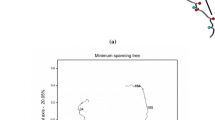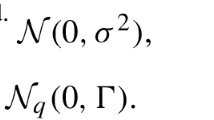Abstract
Normal mixtures are applied in interval mapping to model the segregation of genotypes following Mendel's Law in successive generations of crossing. Standard methods use least squares or maximum likelihood estimates. Theoretically, maximum likelihood is known to result in more efficient estimates than least squares. In the interval mapping literature, some authors state that both methods yield equivalent results, whereas other authors emphasize the higher efficiency of maximum likelihood. The present paper investigates differences of both methods more closely.
We show by example the occurrence of multiple LOD-Score profiles when applying maximum likelihood estimation methods for a basic interval mapping and composite interval mapping model. This analysis results in some peaks of the LOD-Score profile that distinctly differ from F-statistic profiles without being spurious. A spurious profile for IM and CIM was found as well. It is concluded that users of IM and CIM mapping software must be prepared for the rare occurrence of spurious solutions in LOD profiles. The example indicates that especially in sparse marker maps maximum likelihood estimation has a potential to result in non-spurious profiles that are not similar to the F-statistic profiles. However, the discrimination of spurious and non-spurious further profiles is not straightforward in applications. Until the mathematical background of this phenomenon is investigated more thoroughly and rules to ascertain the information content of these additional solutions have been developed, the simultaneous use of the least squares and ML methods may caution against the rare occurrence of spurious results.
Similar content being viewed by others
References
Basten, C.J., B.S. Weir & Z.-B. Zeng, 1999. QTL Cartographer. Department of Statistics, North Carolina State University, Raleigh.
Day, N.E., 1969. Estimating the components of a mixture of normal distributions. Biometrika 56: 463–474.
Emrich, K., 2002. Direkte EM-und Loglikelihood-Profil-Verfahren in Intervallkartie-Rungsmethoden der Pflanzenzucht. Dissertation, Department of Statistics, University of Dortmund. http:// eldorado.uni-dortmund.de:8080.
Groeneveld, E. & M. Kovac, 1990. A note on multiple solutions in multivariate restricted maximum likelihood covariance component estimation. J Anim Sci 73: 2321–2329.
Haley, C.S. & S.A. Knott, 1992. A simple regression method for mapping quantitative trait loci in line crosses using flanking markers. Heredity 69: 315–324.
Kao, C.-H., 2000. On the differences between maximum likelihood and regression interval mapping in the analysis of quantitative trait loci. Genetics 156: 855–865.
Kao, C.-H. & Z.-B. Zeng, 1997. General formulas for obtaining the MLE's and the asymptotic variance–covariance matrix in mapping quantitative trait loci when using the EM algorithm. Biometrics 53: 653–665.
Kao, C.-H., Z.-B. Zeng & R.D. Teasdale, 1999. Multiple interval mapping for quantitative trait loci. Genetics 152: 1203–1216.
Lander, E.S. & D. Botstein, 1989. Mapping mendelian factors underlying quantitative traits using RFLP linkage maps. Genetics 121: 185–199.
Lander, E.S., P. Green, J. Abrahamson, A. Barlow, M.J. Daly, S.E. Lincoln & L. Newburg, 1987. MAPMAKER: An interactive computer package for constructing primary genetic linkage maps of experimental and natural populations. Genomics 1: 174–181.
Ljungberg, K., S. Holmgren & Ö. Carlborg, 2002. Efficient algorithms for quantitative trait loci mapping problems. J Comp Biol 9(6): 793–804.
Louis, T.A., 1982. Finding the observed information matrix when using the EM algorithm. J R Statist Soc B 44: 226–233.
McLachlan, G. & T. Krishnan, 1997. The EM Algorithm and Extensions, Wiley.
McLachlan, G. & D. Peel, 2000. Finite Mixture Models, Wiley.
Melchinger, A.E., H.F. Utz & C.C. Schön, 1998. Quantitative trait locus (QTL) mapping using different testers and independent population samples in maize reveals low power of QTL detection and large bias in estimates of QTL effects. Genetics 149: 383–403.
Meng, X.-L. & D.B. Rubin, 1993. Maximum likelihood estimation via the ECM algorithm: A general framework. Biometrika 80: 267–268.
Redner, R.A. & H.F. Walker, 1984. Mixture densities, maximum likelihood and the EM algorithm. SIAM Rev 26: 195–239.
Seidel, W., K. Mosler & M. Alker, 2000. A cautionary note on likelihood ratio tests in mixture models. Ann Inst Statist Math 52: 481–487.
Utz, H.F. & A.E. Melchinger, 1996. PLABQTL: a program for composite interval mapping of QTL. J Quant Trait Loci 2: 1–5.
Wu, C.F.J., 1983. Onthe convergence properties of the EM algorithm. Ann Statist 11: 95–103.
Zeng, Z.-B., 1994. Precision mapping of quantitative trait loci. Genetics 136: 1457–1468.
Author information
Authors and Affiliations
Rights and permissions
About this article
Cite this article
Emrich, K., Urfer, W. Benefits and complications of maximum likelihood estimation in (composite) interval mapping methods using EM and ECM. Euphytica 137, 155–163 (2004). https://doi.org/10.1023/B:EUPH.0000040513.29286.2d
Issue Date:
DOI: https://doi.org/10.1023/B:EUPH.0000040513.29286.2d




